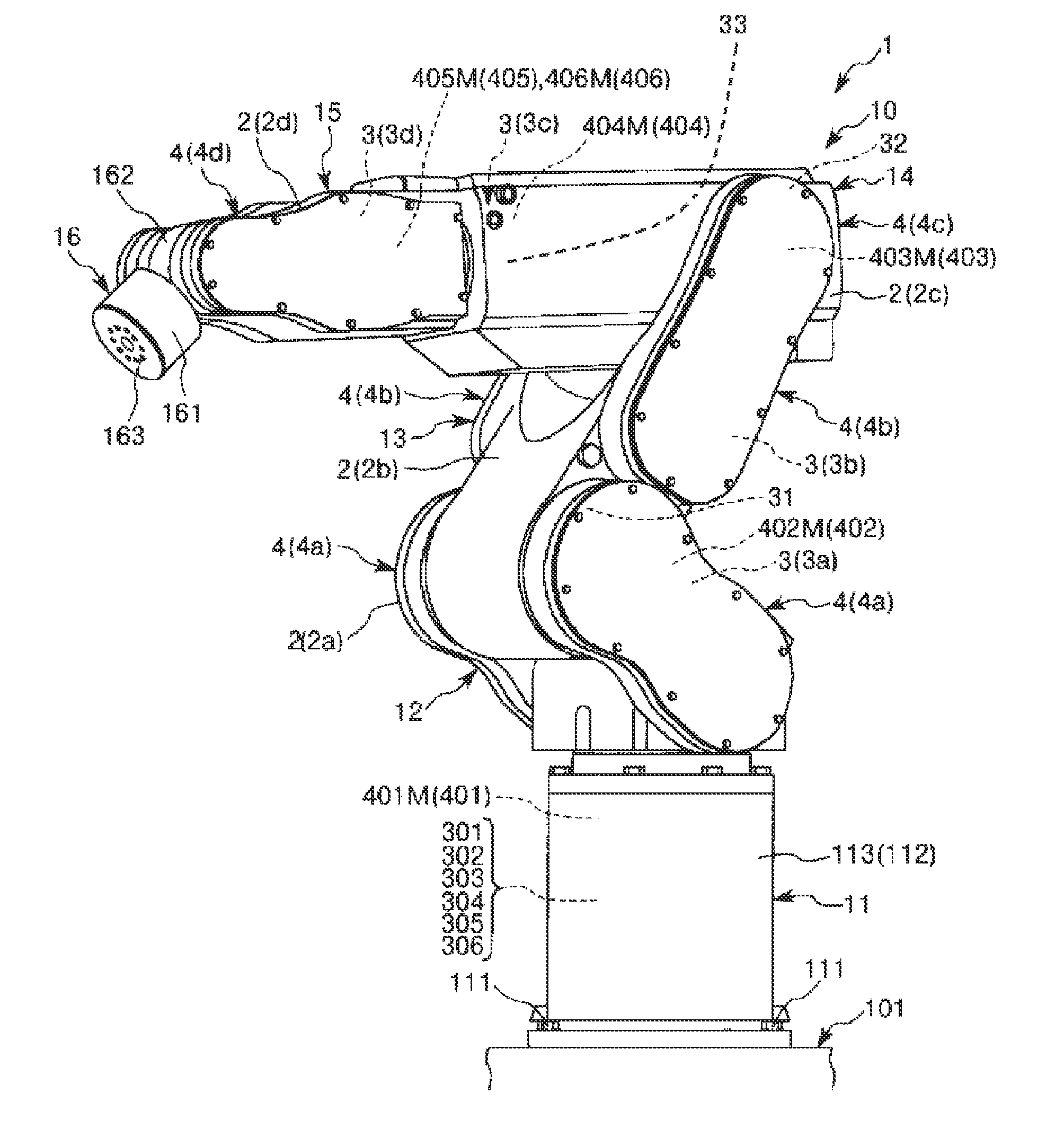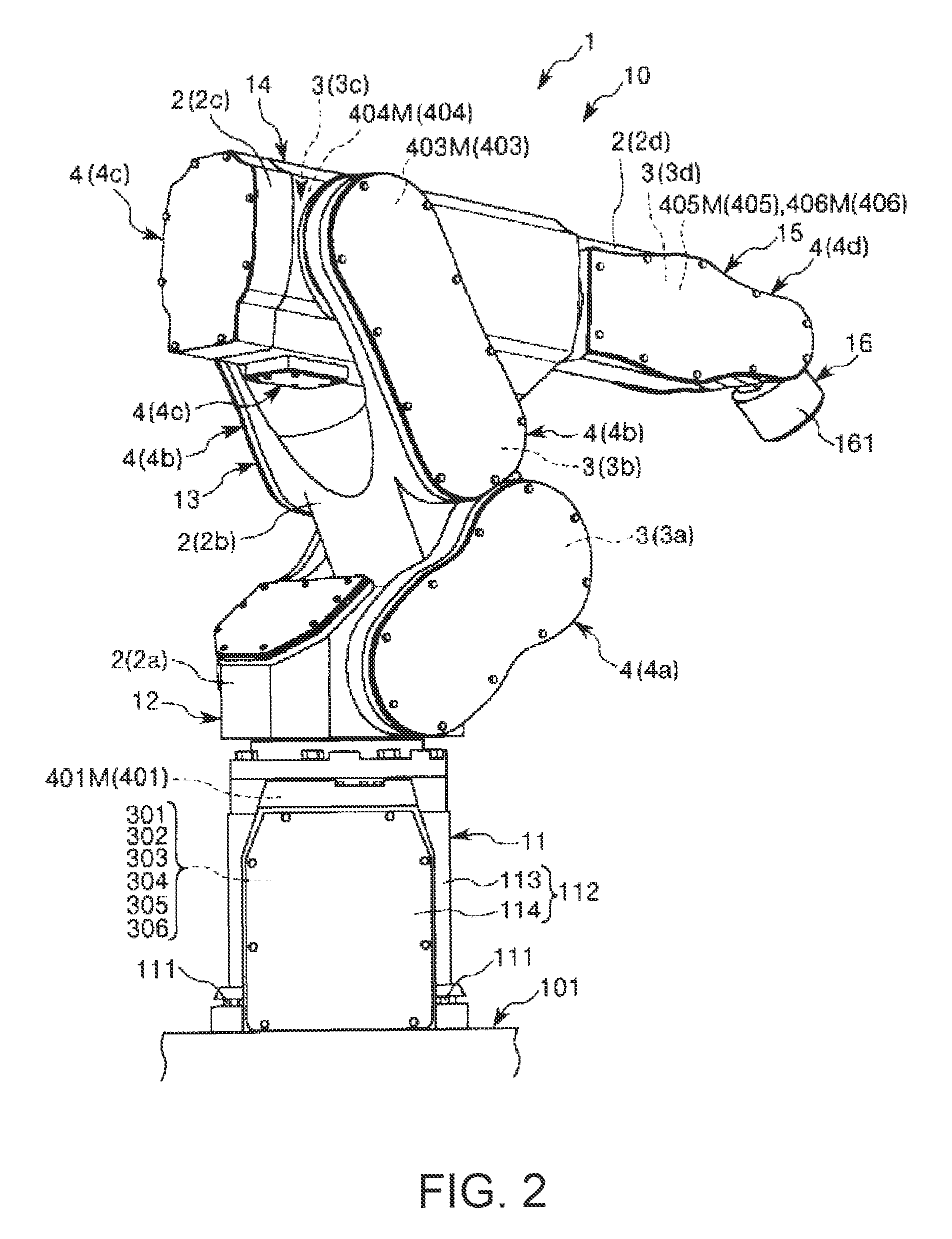Robot
a robot and arm technology, applied in the field of robots, can solve the problems of large amount of calculation, slow response speed, easy generation of vibration in the arm link portion, etc., and achieve the effect of easily and reliably suppressing vibration in the robo
- Summary
- Abstract
- Description
- Claims
- Application Information
AI Technical Summary
Benefits of technology
Problems solved by technology
Method used
Image
Examples
first embodiment
[0083]FIG. 1 is the perspective view when a first embodiment of a robot of the invention is viewed from the front side. FIG. 2 is a perspective view when the robot shown in FIG. 1 is viewed from the back side. FIGS. 3 and 4 are schematic views of the robot shown in FIG. 1, respectively. FIG. 5 is a block diagram of main portions of the robot shown in FIG. 1. FIGS. 6 to 10 are block diagrams of the main portions of the robot shown in FIG. 1, respectively. FIG. 11 is a flowchart showing the control operation of a control device of the robot shown in FIG. 1.
[0084]In addition, in the following, for the convenience of description, the upper side in FIGS. 1 to 4 and FIG. 6 is referred to as “upper” or “upside” and the lower side is referred to as “lower” or “downside”. Additionally, the base side in FIGS. 1 to 4 and FIG. 6 is referred to as a “base end”, and the opposite side is referred to as a “tip”. Additionally, the rotation axes O2 and O3 are shown in an exaggerated manner in FIG. 4,...
second embodiment
[0201]A second embodiment will be described below mainly regarding the differences from the aforementioned first embodiment, and the description of the same matters will be omitted.
[0202]In the robot 1 of the second embodiment, the second drive source controller 202 selects the inertia sensor to be used for the control of the operation of the second drive source 402 for suppressing the vibration in the second arm 13 by taking into consideration tip load mass at the tip portion of the robot 1, that is, at the tip portion of the wrist 16 in addition to the angle θ of the third arm 14. That is, the second drive source controller 202 selects any one of the second inertia sensor 32 and the third inertia sensor 33 by taking into consideration the tip load mass, and controls the operation of the second drive source 402 using a detection result of the selected inertia sensor.
[0203]This tip load mass is the total mass of the manipulator mounted on the tip portion of the wrist 16 that is an a...
third embodiment
[0215]FIG. 12 is a schematic view showing a third embodiment of the robot of the invention. FIG. 13 is a schematic view of the robot shown in FIG. 12. FIG. 14 is a block diagram of main portions of the robot shown in FIG. 12.
[0216]In addition, in the following, for the convenience of description, the upper side in FIG. 12 is referred to as “upper” and “upside” and the lower side is referred to as “lower” and “downside”. Additionally, the base side in FIGS. 12 and 13 is referred to as a “base end”, and the opposite side is referred to as a “tip”. Additionally, inertia sensors 31 and 32 are shown outside the arms 12 and 13 in FIGS. 12 and 13, respectively, in order to clarify the presence of the sensors.
[0217]The third embodiment will be described below mainly regarding differences from the aforementioned first embodiment, and the description of the same matters will be omitted.
[0218]A robot 1B of the third embodiment shown in FIGS. 12 and 13 is referred to as a scalar robot.
[0219]A r...
PUM
 Login to View More
Login to View More Abstract
Description
Claims
Application Information
 Login to View More
Login to View More - R&D
- Intellectual Property
- Life Sciences
- Materials
- Tech Scout
- Unparalleled Data Quality
- Higher Quality Content
- 60% Fewer Hallucinations
Browse by: Latest US Patents, China's latest patents, Technical Efficacy Thesaurus, Application Domain, Technology Topic, Popular Technical Reports.
© 2025 PatSnap. All rights reserved.Legal|Privacy policy|Modern Slavery Act Transparency Statement|Sitemap|About US| Contact US: help@patsnap.com



